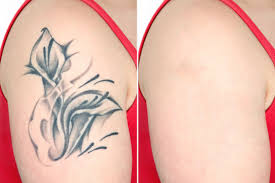Tattoo Removal : A tattoo is a form of body modification, made by inserting ink, either permanent or temporary, into the dermis layer of the skin to change the pigment. Getting a tattoo takes very less time but removal is much more tedious and needs a long duration treatment. Hence one has to think twice before getting a permanent tattoo done. Tattoos which were initially thought to be permanent can now be removed by various methods like LASERS, dermabrasion, chemical peels, cryotherapy or excision surgery.

Tattoo removal is most commonly performed using lasers that break down the ink particles in the tattoo. The broken-down ink is then fought off by the immune system, mimicking the natural fading that time or sun exposure would create. Commonly used LASERS include Q-switched Nd:YAG, Q-switched Alexandrite, Q-switched Ruby LASER.
The procedure can be made painless by applying anesthetic cream prior to procedure. Rare side effects include infection, scarring and pigmentation. Complete laser tattoo removal requires numerous treatment sessions, typically spaced at least 6 weeks apart. At each session, some but not all of the tattoo pigment particles are effectively fragmented, and the body removes the smallest fragments over the course of several weeks. The number of sessions and spacing between treatments depends on various parameters, including the area of the body treated and skin color.